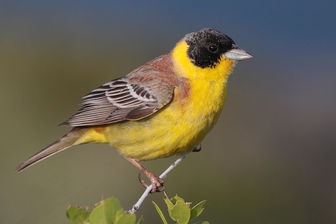Black-headed Bunting
It breeds in southeast Europe east to Iran. It is migratory, wintering in India. It is a rare but regular wanderer to western Europe.

Original source: Own work
Author: Mark S JoblingPermission(Reusing this file)Own work
Permission: GNU Free Documentation License
The Black-headed Bunting is classified as Least Concern. Does not qualify for a more at risk category. Widespread and abundant taxa are included in this category.
The Black-headed Bunting, Emberiza melanocephala, is a passerine bird in the bunting family Emberizidae, a group now separated by most modern authors from the finches, Fringillidae. It breeds in southeast Europe east to Iran. It is migratory, wintering in India. It is a rare but regular wanderer to western Europe. Black-headed Bunting breeds in open scrubby areas including agricultural land. It lays 4-6 eggs in a nest in a tree or bush. More
Black-headed Bunting breeds in open scrubby areas including agricultural land. It lays 4-6 eggs in a nest in a tree or bush. Its natural food consists of insects when feeding young, and otherwise seeds. Description: This bird is 17cm long, larger than Reed Bunting, and long-tailed. The breeding male has bright yellow underparts, chestnut upperparts and a black hood. More
Nest and eggs of black-headed bunting© Theodosis Mamais Nest and chicks of black-headed bunting© Theodosis Mamais Black-headed bunting female portrait© Michelle & Peter Wong Male black-headed bunting, non-breeding plumage© Niranjan Sant Female black-headed bunting, rear view© Michelle & Peter Wong Male black-headed bunting perched on fence© Kerstin Hinze / Biosphoto Female black-headed bunting by water© Richard Brooks / www.flpa-images.co.uk Black-headed bunting male stood in water© R. J. C. More
The Black-headed Bunting breeds in open scrubby areas including agricultural land. It lays 4-6 eggs in a nest in a tree or bush. Its natural food consists of insects when feeding young, and otherwise seeds. More
here's a shot of a male Black-headed Bunting proclaiming his territory. This species is found in SW Europe and the Middle-East and is generally a late arriving migrant from its wintering grounds in central and western India. Only encountered in ones and twos and the start of our stay it was ubiqitous by the end. This species has occurred in Ireland on occasion but, because of its popularity in the cage-bird trade, some of these sightings have been deemed to be escapes from captivity rather than naturally occurring. More
For the purposes of our bird news services, Black-headed Bunting is classed as Rare: species currently considered for acceptance by the British Birds Rarities Committee (or forms of equivalent rarity). More
The Black-headed Bunting breeds in southeast Europe east into regions south of the Caspian Sea and winters mainly in western and central India (Byers, Olsson and Curson, 1995). More
the closely related Black-headed Bunting, despite the latter have a more westerly breeding range. Reports in Britain have declined dramatically over recent years, co-inciding with the decline in Asiatic imports for the cage-bird trade. Juvenile in Kinnerasani Wildlife Sanctuary, Andhra Pradesh, India. Red-headed Bunting breeds in open scrubby areas including agricultural land. It lays 3-5 eggs in a nest in a tree or bush. Its natural food consists of insects when feeding young, and otherwise seeds. More
Black-headed Bunting records in the Western Isles Very rare visitor (five or less records) TBC The chart below shows how abundant the Black-headed Bunting is during a month or when you are more likely to see it. More
Black-headed Buntings do not have " a first-summer plumage as such...some first-summer individuals are surely % ageable as such if in a suitably retarded plumage" (pers comm 27th May 2003). Perhaps, then, such individuals as the one here are not so unusual? As always, comments from those with experience of the species are most welcome. - References Byers, Olsson and Curson, 1995. Buntings and Sparrows. Millington, R. 1995. More
Black-headed Bunting, Suffolk, Gunton 24/09/02 © Tim Brown Taken with a Nikon Coolpix 4500 through a Zeiss Diascope 20-60 zoom. 6"x4" prints available �2. More

Original source: Aviceda
Author: Aviceda
Permission: Some rights reserved
Family : Emberizidae
Genus : Emberiza
Species : melanocephala
Authority : Scopoli, 1769

